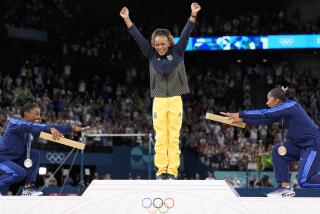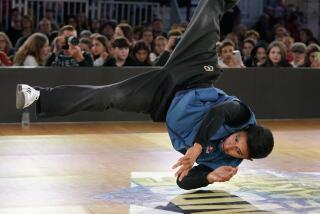World Goes to Nagano
- Share via
It’s not by chance that the men’s downhill race today is the first big event of the XVIII Winter Olympics in Nagano, Japan, and that the women’s figure skating finals are not until Feb. 20, two days before the closing ceremony. As the premier event in alpine ski racing, the downhill will lure television audiences early to the Games. Interest and excitement will build as the days glide by, mounting to the titanic battle for the women’s figure skating gold medal. In the interim, the world will hear personal stories of athletes, learn something about Buddhism, Japanese culture and food and ponder why the biathlon is an Olympic event.
There will be keen interest, or at least curiosity, about the new events of snowboarding, curling and women’s ice hockey. There will be trivia such as who is the only American to have won two Winter Olympics gold medals in ski racing? (Andrea Mead Lawrence, now a Mono County supervisor living in Mammoth Lakes, in the slalom and giant slalom at Oslo in 1952.) And perhaps Americans will finally learn just how to pronounce Nagano. Equal emphasis on all three syllables seems to be preferred.
Speed distinguishes the winter events. Humans can go faster on skis or skates than on foot. And when they fall, they tend to fall harder and more spectacularly. The snowy mountain terrain adds an eloquence to the venues that is lacking in the urban settings of the Summer Games.
The commentators will pick favorites and sometimes, we hope, they will be wrong. The United States might produce an upset of sorts if Kristina Koznick of Burnsville, Minn., wins a medal in the women’s slalom. Koznick recently won a World Cup race and appears to be peaking at age 22.
Some Americans may expect Picabo Street and Tommy Moe to repeat their downhill medal performances from the last Winter Olympics, in Lillehammer, Norway. Don’t count them out, but both have been dogged by injuries. Keep your eye on Germany’s Katja Seizinger, who won the gold in 1994 and has been burning up the slopes this year. Austria’s Hermann Maier is the current favorite in the men’s downhill.
But past records can mean little in the Games. This is about putting everything on the line for just one event. Even the most expert skier or skater can crash off the course or fall. A virtual unknown can put together the performance of his or her life to win.
A certain amount of nationalism is inescapable. Americans want to see Americans winning gold medals. We can only hope the commentators do not dwell on the national team standings. Those who ascend the medal podium represent perfection beyond mere borders.
The Olympics are about young athletes from nations throughout the world mixing and learning about sportsmanship, fellowship and peace.
The most poignant moment at Lillehammer came when Juan Antonio Samaranch, the president of the International Olympic Committee, asked the audience to stand in silence in memory of Sarajevo, site of the 1984 Games. The Bosnian city had been devastated by war.
Also in 1994, former U.S. Olympic ski racer Christin Cooper and others formed a group called Spirit of Hope. They returned to Sarajevo and, wearing flak jackets, organized makeshift competition amid the ruins. Sarajevans were determined to get outside despite the continuing danger, Cooper recalled in Ski Magazine. “The Olympic spirit isn’t about medals,” she said. “It’s about the humanity of sport.”
More to Read
Go beyond the scoreboard
Get the latest on L.A.'s teams in the daily Sports Report newsletter.
You may occasionally receive promotional content from the Los Angeles Times.






